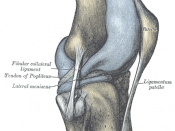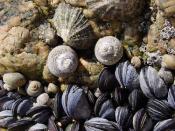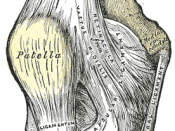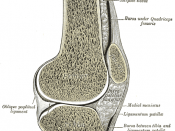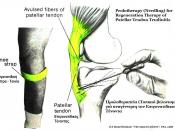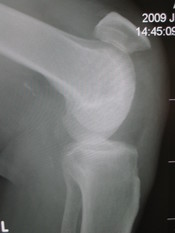Patellar Tendonitis
The patellar ligament is a strong, flat, ligamentous band, about 8 cm in length. It is very odd because it can be called a ligament or a tendon. It can be a ligament because it connects the femur with the patella and the tibia and a tendon because it joins the quadriceps femoris and parts of the gastrocenimus. It is attached, at the top to apex and adjoining margins of the patella and the rough depression on its posterior surface. At the bottom it is connected to the tuberosity of the tibia. The superficial fibers of the ligament are continuous over the front of the patella that starts from the tendon of the quadriceps femoris and ends at the tibia. The medial and lateral parts of the tendon of the quadriceps femoris pass down on both sides of the patella, and continue into the upper extremity of the tibia where the patellar ligament meets the tuberosity.
These portions converge into what is called the capsule forming the medial and lateral patellar retinacula. The dorsal surface of the "ligamentum patellæ" is kept away from the synovial membrane of the knee joint by a large infrapatellar padding of fat. The ligament is also protected from the tibia by a bursa. A bursa is a fluid-filled body sac that reduces friction around joints or between other parts that rub against one another. This bursa is very pivotal as it also helps increase the movement of the ligament. The patellar ligament functions primarily to assist the lower leg muscles, allowing movement. This ligament is generally in use while a person is jumping, pedaling the bicycle, and when kicking a ball.
Patellar tendonitis is a condition that is depicted as an injury affecting the tendons that connects the patella or kneecap to the tibia or shinbone. It occurs when the tendon, or ligament, and the tissues that surround it, become inflamed, or swollen, and irritated. The ligament, or tendon, may also appear to get some small tears which the body may attempt to repair, but if it can't keep up, the inflammation in the tendon may worsen. This inflammation is usually due to overuse, especially from jumping activities. This is the reason patellar tendonitis is also called "jumper's knee." Extensive workouts can also be to blame. Patellar tendonitis is also seen with sports such as running, soccer, hockey and baseball in some cases. Some people develop patellar tendonitis after already sustaining an injury to the tendon, and not allowing enough healing time. As of today, doctors are still unable to pinpoint the exact reason these activities cause patellar tendonitis. However, it is believed that there are certain factors that might make people more susceptible to this injury. Among these are muscular imbalances in the leg, where stronger muscles such as the quadriceps femoris, pull harder on the patellar region. Other symptoms that make people more prone are raised kneecaps, leg misalignments, tightness in the leg muscles, and continued stress on the patellar tendon, or ligament. Although patellar tendinitis' commonly known name is,"jumper's knee", anyone can be affected by patellar tendinitis, whether they are frequent jumper's or not.
Terms that doctors sometimes use to describe chronic patellar tendinitis that further causes the deterioration of the patellar ligament include patellar tendinopathy and patellar tendinosis. A person with patellar tendonitis is usually told to rest, but seeing a physical therapist is also recommended. At the physical therapist they will work on the knee joints flexibility and they will also work the muscles around the patellar region to strengthen them and provide less strain on it. Someone with pain in this region and have the symptoms mentioned and are also involved in the activities should go see their orthopedic doctor for more information and a check-up.
Works Cited
Cluett, Jonathan. "Patellar Tendonitis." About.com. 18 Feb. 2006. Medical Review Board. <http://orthopedics.about.com/cs/patelladisorders/a/patellartendon.htm>.
Matt. "Patellar Tendonitis." Orthopod. 12 Aug. 2008. Medical MultiMedia Group. <http://www.eorthopod.com/public/patient_education/9736/patellar_tendonitis.html>.
Mayo Clinic Staff. "Patellar Tendonitis." MayoClinic.com. 8 Jan. 2008. Mayo Foundation for Medical Education and Research. <http://www.mayoclinic.com/health/patellar-tendinitis/ds00625>.
Sanchis-Alfonso, Vicente. Anterior Knee Pain and Patellar Instability. New York, NY: Springer, 2005. 260+.
